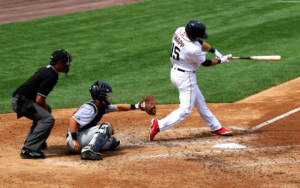Soccer (many countries know soccer as football) is the most popular sport globally and has been played for centuries worldwide. It is a team sport that involves kicking a round ball into the opposing team’s goal, with each team having 11 players. The game is played on a rectangular field, usually grass or artificial turf, with a goal at each end. FIFA sets the rules in the world of soccer (Fédération Internationale de Football Association). The FIFA ensures that the official laws are enforced at international soccer tournaments like the World Cup and UEFA Champions League. Soccer requires agility, speed, and skill and can be very physical. Players wear jerseys with their team’s colors, shorts, shin guards, cleats, or sneakers, and may also wear protective headgear. Soccer is sometimes called “The Beautiful Game” because of its speed and gracefulness. Over 3 billion people around the world watch soccer matches annually!
The world of soccer, or football in most countries outside of North America, is a vast and dynamic sport that captivates millions of fans around the globe. Here are some critical aspects of the soccer world:
- Popularity: Soccer is the world’s most popular sport, with a massive following in virtually every corner of the globe. The sport’s popularity is reflected in the huge viewership of major tournaments such as the FIFA World Cup, UEFA Champions League, Copa America, and various domestic leagues.
- Global Competitions: The pinnacle of international soccer is the FIFA World Cup, held every four years and featuring national teams from around the world. Other major international competitions include the UEFA European Championship, Copa America, and the Africa Cup of Nations.
- Domestic Leagues: Each country typically has its domestic soccer league system, with multiple tiers of competition. Some of the most renowned leagues include the English Premier League, La Liga (Spain), Serie A (Italy), Bundesliga (Germany), and Ligue 1 (France). These leagues feature some of the best clubs and players in the world.
- Clubs: Soccer clubs play a crucial role in the sport’s ecosystem. Famous clubs like FC Barcelona, Real Madrid, Manchester United, Bayern Munich, and AC Milan boast rich histories and large fan bases. The success of clubs is often measured by their performance in domestic leagues and international competitions.
- Players: Soccer has produced legendary players who have become household names. Icons like Pelé, Diego Maradona, Lionel Messi, and Cristiano Ronaldo have left an indelible mark on the sport. The FIFA Ballon d’Or is awarded annually to the best player in the world.
- Transfers: The soccer transfer market is a major aspect of the sport. Clubs buy and sell players in transfer windows, with astronomical sums often involved. High-profile transfers capture the attention of fans and the media, and they can significantly impact a team’s fortunes.
- Technology and VAR: In recent years, soccer has embraced technology to aid match officials. Video Assistant Referee (VAR) technology has been introduced in many leagues and competitions to review key decisions, reducing human errors.
- Fan Culture: Soccer has a passionate and diverse fan culture. Fans often support their teams with unwavering loyalty, and matches are characterized by lively atmospheres in stadiums. Chants, songs, and unique traditions are part of the rich tapestry of soccer fandom.
- Challenges: The sport also faces challenges, including issues related to governance, financial disparities between clubs, racism, and fan behavior. Efforts are ongoing to address these challenges and promote a more inclusive and fair soccer environment.
Overall, the world of soccer is dynamic, ever-evolving, and deeply ingrained in the cultural fabric of many societies.
Authors Note: When people begin to see the value of any sport, a positive change or transformation starts in their life(s).




